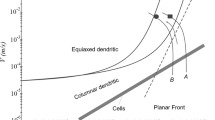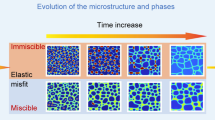Abstract
The mechanisms of abnormal grain growth (AGG) in particle-containing systems have long been a mystery. Recently, we reported that a non-random particle distribution can induce a grain size advantage and trigger AGG. However, the processing conditions leading to a non-random particle distribution are far from being understood. Here, we investigate the particle distribution and concomitant grain growth behavior at different annealing temperatures and times in an Al-3.5 wt pct Cu alloy by scanning electron microscopy (SEM). At high temperatures and long times, the particle distribution evolves from random to non-random, with an accompanying transition from normal grain growth (NGG) to AGG. Analytical calculations suggest that a non-random particle distribution is introduced by residual Cu segregation even after homogenization. In short, the corresponding fluctuation of θ-Al2Cu phase distribution is amplified at elevated temperatures via particle dissolution. We quantify the spatial inhomogeneity of particles through the Gini coefficient and link this important parameter to the critical grain size necessary for AGG. The trends are conveyed succinctly in a temperature–time–(structural) transformation (TTT) diagram, which identifies the onset of AGG in an Al-3.5 wt pct Cu alloy.










Similar content being viewed by others
References
E.O. Hall, Proc. Phys. Soc. B 64, 747–753 (1951)
N.J. Petch, J. Iron Steel Inst. 173, 25–28 (1953)
G.S. Rohrer, Metall. Mater. Trans. A 41A, 1063–1100 (2010)
P.A. Manohar, M. Ferry, T. Chandra, ISIJ Int. 38, 913–924 (1998)
J.E. Burke, AIME Trans. 180, 73–91 (1949)
J.E. Burke, D. Turnbull, Prog. Met. Phys. 3, 220–292 (1952)
J. Humphreys, G.S. Rohrer, A. Rollett, in Recrystallization and Related Annealing Phenomena, 3rd edn., ed. by J. Humphreys, G.S. Rohrer, A. Rollett (Elsevier, Oxford, 2017), pp. 375–429
I.M. Lifshitz, V.V. Slyozov, J. Phys. Chem. Solids 19, 35–50 (1961)
C. Wagner, Z. Elektrochem. Ber. Bunsenges. Phys. Chem. 65, 581–591 (1961)
M. Hillert, Acta Metall. 13, 227–238 (1965)
D. Duly, G.J. Baxter, H.R. Shercliff, J.A. Whiteman, C.M. Sellars, M.F. Ashby, Acta Mater. 44, 2947–2962 (1996)
J.E. May, D. Turnbull, Trans. Metall. Soc. AIME 212, 769 (1958)
J. Calvet and C. Renon: Mém. Sci. Rev. Métall., 1960, vol. 57.
A. Gangulee, F.M. D’Heurle, Thin Solid Films 12, 399–402 (1972)
T. Gladman, Mater. Sci. Forum 94–96, 113–128 (1992)
I.-J. Bae, S. Baik, J. Am. Ceram. Soc. 80, 1149–1156 (1997)
J. Dennis, P.S. Bate, J.F. Humphreys, Mater. Sci. Forum 558–559, 717–722 (2007)
J. Dennis, P.S. Bate, F.J. Humphreys, Acta Mater. 57, 4539–4547 (2009)
E.A. Holm, T.D. Hoffmann, A.D. Rollett, C.G. Roberts, IOP Conf. Ser. Mater. Sci. Eng. 89, 012005 (2015)
T. Omori, T. Kusama, S. Kawata, I. Ohnuma, Y. Sutou, Y. Araki, K. Ishida, R. Kainuma, Science 341, 1500 (2013)
S. Jin, M. Huang, Y. Kwon, L. Zhang, B.-W. Li, S. Oh, J. Dong, D. Luo, M. Biswal, B.V. Cunning, P.V. Bakharev, I. Moon, W.J. Yoo, D.C. Camacho-Mojica, Y.-J. Kim, S.H. Lee, B. Wang, W.K. Seong, M. Saxena, F. Ding, H.-J. Shin, R.S. Ruoff, Science 362, 1021–1025 (2018)
I. Andersen, Ø. Grong, N. Ryum, Acta Metall. Mater. 43, 2689–2700 (1995)
M.A. Razzak, M. Perez, T. Sourmail, S. Cazottes, M. Frotey, ISIJ Int. 52, 2278–2282 (2012)
G.C. Abbruzzese, C. Forzanti, Mater. Sci. Forum 706–709, 1355–1360 (2012)
G.C. Abbruzzese, J. Phys. Conf. Ser. 1270, 012036 (2019)
P.R. Rios, Acta Mater. 45, 1785–1789 (1997)
N. Lu, J. Kang, N. Senabulya, R. Keinan, N. Gueninchault, A.J. Shahani, Acta Mater. 195, 1–12 (2020)
C. Gini, Riv. polit. econ. 87, 769–790 (1997)
C. Gini: Variabilità e mutabilità (1912).
W.J. Carrington, K.R. Troske, J. Bus. Econ. Stat. 15, 402–409 (1997)
S.J. Rey, R.J. Smith, Lett. Spat. Resour. Sci. 6, 55–70 (2013)
Z.I. Botev, J.F. Grotowski, D.P. Kroese, Ann. Stat. 38, 2916–2957 (2010)
R.W. Balluffi, Kinetics of Materials (Wiley, Hoboken, NJ, 2005).
S. Fujikawa, K. Hirano, J. Jpn Inst. Light Met. 20, 267–277 (1970)
E. Nes, N. Ryum, O. Hunderi, Acta Metall. 33, 11–22 (1985)
A.W. Bowen, M.G. Ardakani, J.F. Humphreys, Mater. Sci. Forum 157–162, 919–926 (1994)
J. Humphreys, G.S. Rohrer, A. Rollett, in Recrystallization and Related Annealing Phenomena, 3rd edn., ed. by J. Humphreys, G.S. Rohrer, A. Rollett (Elsevier, Oxford, 2017), pp. 109–143
S.-J.L. Kang, in Sintering. ed. by S.-J.L. Kang (Butterworth-Heinemann, Oxford, 2005), pp. 117–135
J.O. Andersson, T. Helander, L. Höglund, P. Shi, B. Sundman, CALPHAD 26, 273–312 (2002)
W.F. Smith, J. Hashemi, F. Presuel-Moreno, Foundations of Materials Science and Engineering (McGraw-Hill Publishing, New York, 2006).
V. Bezák, Metall. Trans. 3, 1235–1237 (1972)
H. Fredriksson, U. Åkerlind, Materials Processing During Casting (Wiley, Hoboken, NJ, 2006), pp. 227–253
S. Nag, Y. Zheng, R.E.A. Williams, A. Devaraj, A. Boyne, Y. Wang, P.C. Collins, G.B. Viswanathan, J.S. Tiley, B.C. Muddle, R. Banerjee, H.L. Fraser, Acta Mater. 60, 6247–6256 (2012)
E.M. Lifshitz, L.P. Pitaevskii, Statistical Physics: Theory of the Condensed State (Elsevier, Amsterdam, 2013).
X. Wang, Z. Huang, B. Cai, N. Zhou, O. Magdysyuk, Y. Gao, S. Srivatsa, L. Tan, L. Jiang, Acta Mater. 168, 287–298 (2019)
S. Birosca, A. Nadoum, D. Hawezy, F. Robinson, W. Kockelmann, Acta Mater. 185, 370–381 (2020)
Acknowledgments
We gratefully acknowledge financial support from the Army Research Office Young Investigator Program under Award No. W911NF-18-1-0162. We also acknowledge the University of Michigan College of Engineering for financial support and the Michigan Center for Materials Characterization for use of the instruments and staff assistance.
Author information
Authors and Affiliations
Corresponding author
Additional information
Publisher's Note
Springer Nature remains neutral with regard to jurisdictional claims in published maps and institutional affiliations.
Manuscript submitted September 1, 2020; accepted December 14, 2020.
Supplementary Information
Below is the link to the electronic supplementary material.
Appendix
Appendix
Based on the Smith–Zener pinning mechanism, grain size is inversely proportional to particle phase fraction (neglecting the particle size), as \({R}_{\mathrm{n}}^{\mathrm{m}}\left(S\right)=\frac{k}{{f}_{\theta }\left(S\right)}\) , where k is a coefficient. We assume a one-dimensional space parametrized by a coordinate \(S\). The grain size departure \(\Delta {R}_{\mathrm{n}}\) could be approximately estimated as \(\Delta {R}_{\mathrm{n}}={R}_{\mathrm{n}}^{\mathrm{m}}(S){^{\prime}}*\Delta S\), where \({R}_{\mathrm{n}}^{\mathrm{m}}(S){^{\prime}}\) is the spatial derivative of a continuous function \({R}_{\mathrm{n}}^{\mathrm{m}}(S)\). Using this information, we can express the magnitude of the inhomogeneity parameter \(\delta =\Delta {R}_{\mathrm{n}}/{R}_{\mathrm{n}}\) as
The distance \(\Delta S\) could be thought of as \({R}_{\mathrm{ab}}-{R}_{\mathrm{n}}\). Assuming that \({R}_{\mathrm{ab}}\) needs to have double the normal grain size \({R}_{\mathrm{n}}\) to trigger AGG, \(\Delta S\) could be simplified as \({\Delta S=R}_{\mathrm{ab}}-{R}_{\mathrm{n}}={2R}_{\mathrm{n}}-{R}_{\mathrm{n}}={R}_{\mathrm{n}}\). Based on Eq. [3] in the main text, the maximal \(\left|\mathrm{ln}({f}_{\theta }\left(S\right)){^{\prime}}\right|\) are obtained at \(S=\lambda /4\). Putting it all together,
In Eq. [A2], parameters a and b describe the spatial distribution of θ-Al2Cu phase. To connect our experimental work to theory, we relate \({\left|\delta \right|}_{\mathrm{max}}\) to the Gini coefficient \(G\) in what follows.
Setting \(h=2S/\lambda \), we normalize the phase distribution \({f}_{\theta }\left(S\right)\) as \({f}_{\theta }(\frac{\lambda }{2}*h)\),
The half period of \(\left[0,\lambda /2\right]\) thus becomes \(\left[0,h\right]\). Then, we can calculate the Lorenz curve (L) by integrating the normalized function \({f}_{\theta }(\frac{\lambda }{2}*h)\) in the half period of \(\left[0,h\right]\):
Next, we determine the area under Lorenz curve [see blue region in Figure 1(c)] as
Finally, the Gini coefficient is computed as
Combining Eqs. [A2] and [A6], we link the inhomogeneity parameter to the Gini coefficient:
Rights and permissions
About this article
Cite this article
Lu, N., Kang, J. & Shahani, A.J. Origins of Non-random Particle Distributions and Implications to Abnormal Grain Growth in an Al-3.5 Wt Pct Cu Alloy. Metall Mater Trans A 52, 914–927 (2021). https://doi.org/10.1007/s11661-020-06125-0
Received:
Accepted:
Published:
Issue Date:
DOI: https://doi.org/10.1007/s11661-020-06125-0




